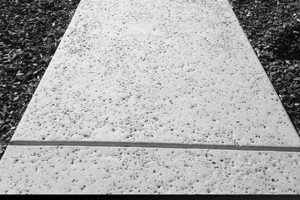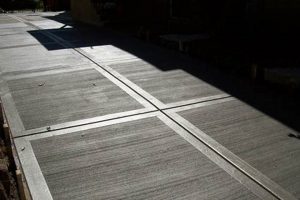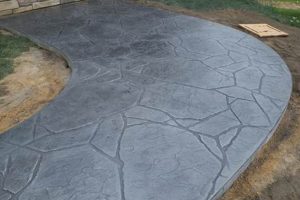The designations given to implements employed in the final stages of concrete placement and treatment constitute a specialized vocabulary within the construction trades. These implements are critical for achieving desired surface characteristics, influencing factors such as smoothness, texture, and durability. A bull float, for instance, extends reach and flattens fresh concrete, while a hand trowel creates a smooth, dense finish.
The proper selection and utilization of these specialized instruments is paramount to the longevity and aesthetic appeal of concrete structures. Historically, basic wooden floats and hand trowels sufficed. Modern applications, however, often necessitate a broader array, including power trowels for large areas and specialized edging tools to refine perimeter details. Selecting appropriate implements directly impacts project efficiency and the ultimate quality of the hardened concrete.
The subsequent sections will explore specific categories of these instruments, detailing their respective functions and optimal applications. These categories include tools for leveling, smoothing, texturing, and edging concrete surfaces, providing a detailed understanding of their roles in the finishing process.
Concrete Finishing Tools
Effective utilization of implements designed for concrete surface refinement requires careful consideration of various factors. The following outlines key guidelines to optimize the finishing process and achieve desired results.
Tip 1: Timing is Crucial: Commence finishing operations only after bleed water has evaporated from the concrete surface. Premature finishing can trap water, leading to surface weakness and potential scaling.
Tip 2: Select the Appropriate Float: Match the float material to the desired finish. Magnesium floats are suitable for opening the surface and embedding aggregate, while wooden floats offer a coarser texture. Using the wrong float can compromise the texture and durability.
Tip 3: Employ a Consistent Technique: Maintain a uniform angle and pressure when using hand tools. This consistency prevents unevenness and ensures a consistent surface appearance. Varying technique can leave visible marks and inconsistencies.
Tip 4: Power Trowel Proficiency: When using power trowels, overlap passes and gradually increase blade pitch. This ensures a smooth, dense surface without burning or creating chatter marks.
Tip 5: Edging for Durability: Rounding the edges of concrete slabs with an edging tool protects them from chipping and spalling. This practice enhances both the appearance and structural integrity of the concrete.
Tip 6: Clean Tools Regularly: Keep implements clean during use to prevent the transfer of hardened concrete or debris onto the surface. This simple step can significantly improve the quality of the finish.
Tip 7: Curing is Non-Negotiable: Proper curing is essential for concrete strength and durability. Begin curing immediately after finishing to prevent rapid moisture loss and cracking.
Adhering to these guidelines promotes the creation of durable, aesthetically pleasing concrete surfaces. Proper execution results in a finished product that meets both functional and visual requirements.
The information provided constitutes essential knowledge for anyone involved in concrete placement and finishing. Further, more specialized practices may be required based on project-specific requirements and local regulations.
1. Float types
Within the realm of concrete finishing, “Float types” represent a significant subset of implement designations, directly influencing surface characteristics. Categorization by material, size, and intended application provides a granular level of specificity when discussing “concrete finishing tools names”.
- Magnesium Floats
Constructed from magnesium alloy, these tools are lightweight and effective for opening the concrete surface and embedding aggregate during initial finishing stages. Their properties prevent the concrete from sticking, facilitating smoother manipulation, especially in wetter conditions. Misidentification of a magnesium float can result in improper surface preparation, leading to issues like scaling or delamination.
- Wooden Floats
Crafted from wood, typically hardwood, these floats impart a coarser texture compared to magnesium. They are employed when a non-slip surface is desired, often in exterior applications. Use of a wooden float when a smooth surface is required, exemplifies the critical importance of accurate “concrete finishing tools names” knowledge, potentially leading to rework and cost overruns.
- Bull Floats
Distinguished by their large size and long handles, bull floats are used to flatten and level large concrete slabs immediately after screeding. They are critical for removing imperfections and ensuring a uniform surface prior to further finishing. Failure to correctly identify and utilize a bull float in the initial stages will compromise subsequent finishing steps.
- Channel Floats
These specialty floats feature channels on their surface designed to create defined grooves and textures. Applications include creating slip-resistant surfaces or decorative patterns. Accurate identification and appropriate use are essential for achieving the intended aesthetic and functional outcome.
In summary, the proper identification and application of specific float types, a key component within “concrete finishing tools names”, are directly tied to the quality and functionality of the finished concrete surface. Misapplication or incorrect identification leads to compromised results. A thorough understanding of the specific properties and uses of each float type is crucial for successful concrete finishing.
2. Trowel variations
The specific nomenclature applied to trowels forms a critical component within the broader lexicon of “concrete finishing tools names”. Trowel selection dictates the final surface smoothness and density achievable on a concrete slab, impacting both aesthetic appeal and functional performance. Variations arise from blade material, size, shape, and intended application, each impacting the final surface characteristics of the concrete.
- Hand Trowels
Hand trowels are characterized by their rectangular blade and manual operation. They are employed for achieving a smooth, dense finish on smaller areas or for detailed work around edges and forms. The blade material, typically steel, imparts varying degrees of smoothness. Inaccurate use of a hand trowel, or misidentification with another tool, can lead to an uneven or marred surface requiring rework.
- Power Trowels
Power trowels, also known as rotary trowels, are mechanized units designed for finishing large concrete slabs efficiently. They utilize rotating blades enclosed within a safety cage. Blade pitch adjustment allows for varying the degree of smoothness. Improper operation, such as over-troweling, can result in surface burning or delamination, underscoring the need for proficiency in their operation and accurate tool naming.
- Fresno Trowels
Fresno trowels are long-handled trowels used to smooth and finish concrete from a distance. Their extended reach allows finishers to work on large areas without kneeling or walking on the fresh concrete. This minimizes surface imperfections. The weight and length necessitate skill in handling to avoid unevenness. Accurate identification and appropriate application of a Fresno trowel are vital for achieving uniform results on expansive surfaces.
- Float Trowels
Combining features of both floats and trowels, float trowels have a wider blade than a standard hand trowel and are often used after floating to further refine the surface. They help in creating a smoother, more uniform finish than a float alone can provide, bridging the gap between initial floating and final troweling stages. Their specific design purpose requires their correct identification and employment within the “concrete finishing tools names” hierarchy.
The described trowel variations, each with unique attributes and applications, reinforce the critical role of precise “concrete finishing tools names” knowledge. Selecting the correct trowel, wielded with proper technique, directly influences the durability, appearance, and overall quality of the completed concrete surface. Variations in trowel type and usage are fundamental aspects of concrete finishing practice.
3. Edger designs
Edger designs constitute a crucial subset within the broader category of “concrete finishing tools names”. These specialized implements are employed to create a rounded or beveled edge on concrete slabs, primarily to enhance durability and prevent chipping or spalling. The design characteristics of an edger directly influence its effectiveness in achieving this objective, thereby affecting the longevity and aesthetic appeal of the finished concrete work. Misidentification or misuse of an edger can result in edges that are prone to damage or that detract from the overall appearance of the structure. For instance, using an edger with too large of a radius on a thin slab can weaken the edge rather than strengthen it.
Variations in edger design include differences in blade radius, blade material, and handle configuration. A smaller radius is typically used for thinner slabs, while a larger radius is appropriate for thicker concrete elements. Blade material influences the smoothness and precision of the edge created. Stainless steel edgers, for example, offer greater resistance to corrosion compared to carbon steel models, which is particularly relevant in environments with high moisture exposure. Handle design impacts user comfort and control, affecting the consistency and quality of the finished edge. Consider a scenario where a worker utilizes an edger with an ergonomically poor handle design, leading to fatigue and inconsistent edge finishing across a large project. Therefore, understanding the nuances of “edger designs” within “concrete finishing tools names” is crucial for achieving desired outcomes.
In summary, the selection and proper utilization of edgers, informed by a clear understanding of “edger designs” as a component of “concrete finishing tools names”, is essential for producing durable and aesthetically pleasing concrete edges. Failure to appreciate the specific characteristics and applications of different edger designs can lead to compromised structural integrity and diminished aesthetic quality. Edger selection and technique represent fundamental aspects of concrete finishing expertise.
4. Groover profiles
Groover profiles, representing a distinct category within “concrete finishing tools names”, dictate the shape and depth of control joints cut into concrete slabs. These joints are deliberately created lines of weakness designed to control cracking due to shrinkage and thermal stress. The selection of an appropriate groover profile is not merely an aesthetic consideration; it is a critical engineering decision directly impacting the structural integrity and long-term performance of the concrete slab. A shallow, V-shaped groove, for example, may be suitable for light-duty residential applications, while a deeper, wider groove is necessary for heavy-duty industrial floors subjected to significant loads and temperature fluctuations. Failure to select an appropriate groover profile within the framework of “concrete finishing tools names” can result in uncontrolled cracking, leading to costly repairs and premature deterioration of the concrete structure. The relationship is causal: the profile chosen directly influences the slab’s ability to manage stress.
Practical application further illustrates the significance. Consider a large parking lot. Inadequate joint spacing coupled with an inappropriate groover profile can lead to extensive cracking, especially in regions with extreme temperature variations. The cracks allow water infiltration, which can freeze and thaw, exacerbating the damage and weakening the subbase. Conversely, properly spaced joints cut with the correct groover profile effectively channel cracking along predetermined lines, preserving the overall structural integrity of the pavement. Standard groover profiles include rounded, V-shaped, and U-shaped designs, each offering different performance characteristics related to crack control and load transfer. Furthermore, the dimensions of the groover, specifically its width and depth, must be meticulously chosen based on the slab thickness and anticipated loading conditions. Inappropriate selection of dimensions negates the intended function of the control joint.
In summary, a thorough understanding of groover profiles as a component of “concrete finishing tools names” is paramount for effective concrete slab design and construction. Challenges arise from the complexity of predicting concrete shrinkage and thermal behavior, requiring careful consideration of environmental factors, material properties, and loading conditions. Integrating this knowledge into the selection and utilization of grooving tools ensures the creation of durable, long-lasting concrete structures. The connection underscores the necessity of combining theoretical knowledge with practical application for successful concrete finishing.
5. Tamper styles
The nomenclature associated with tamper styles represents a specific, albeit sometimes overlooked, element within the broader realm of “concrete finishing tools names.” These tools, used primarily for consolidating fresh concrete and embedding aggregate, contribute to the overall density and surface texture, impacting the durability and aesthetic quality of the finished product. Varying designs cater to different applications, demanding accurate identification and appropriate utilization for optimal results.
- Hand Tampers
Hand tampers, characterized by a flat, heavy base attached to a handle, are employed for compacting concrete in confined spaces or along edges. Their manual operation allows for precise control, preventing over-compaction. A common application is consolidating concrete around pipes or forms. Inaccurate use, or confusion with other tools, can result in uneven compaction and potential structural weaknesses, highlighting the relevance of proper “concrete finishing tools names” knowledge.
- Roller Tampers
Roller tampers, featuring a cylindrical drum, are designed for consolidating larger areas of concrete efficiently. They are particularly useful for compacting soil or gravel bases prior to concrete placement, ensuring a stable foundation. In concrete finishing, a light roller tamper can embed aggregate, but misuse can displace the aggregate resulting in a nonuniform surface.
- Plate Compactors
Plate compactors, typically powered by gasoline engines, deliver vibratory force to consolidate concrete or soil. These are best suited for preparing a sub-base for the concrete slab. Though not directly used to finish the concrete itself, incorrect sub-base compaction with such tools can contribute to uneven settlement and cracking of the finished concrete slab. Understanding their role in the overall process highlights the interconnectedness within “concrete finishing tools names” and associated preparatory tasks.
The presented tamper styles, while not always considered primary concrete finishing tools, exert a significant influence on the final outcome. Proper selection and application, informed by a thorough understanding of “concrete finishing tools names” and related techniques, directly contribute to the durability, stability, and overall quality of the finished concrete structure. Misidentification or inappropriate use can compromise structural integrity and aesthetic appeal, underscoring the importance of comprehensive knowledge in this domain.
6. Texture Implements
Texture implements, a critical subset of “concrete finishing tools names,” directly influence the aesthetic and functional properties of finished concrete surfaces. These implements impart patterns and textures, enhancing slip resistance, visual appeal, and even acoustic characteristics. The choice of texture implement is directly correlated with the intended use of the concrete surface and desired performance criteria. For example, a broom finish provides enhanced traction for walkways and driveways, while stamped patterns create decorative surfaces for patios and pool decks. Incorrect selection can compromise safety or aesthetic coherence. Texture implements are not merely cosmetic additions; they actively contribute to the concrete’s utility. The implements used to create such patterns include rubber stamps, texture rollers, and specialized brooms, each requiring specific techniques for successful application.
The practical significance of understanding “texture implements” within “concrete finishing tools names” is evident in various applications. Consider a commercial kitchen floor. A smooth, polished concrete surface would be aesthetically pleasing but dangerously slippery, especially when wet. The application of a texture implement, such as a coarse broom, creates a slip-resistant surface, significantly reducing the risk of accidents. Similarly, in architectural concrete, stamped patterns can mimic natural stone or brick, adding visual interest and value to a structure. The proper employment of texture rollers to produce repetitive patterns demands skill to avoid inconsistencies. Selecting a texture that complements the building’s architectural style requires careful consideration of color, pattern scale, and overall design intent. The relationship between texture selection and overall design impact cannot be overstated.
In conclusion, texture implements represent a vital aspect of “concrete finishing tools names,” impacting both the functional and aesthetic qualities of concrete surfaces. Challenges arise from the need to balance visual appeal with practical considerations, such as slip resistance and durability. Careful selection and skilled application are essential for achieving optimal results. This knowledge is fundamental to professional concrete finishing, bridging the gap between structural integrity and design objectives. The choice directly influences the long-term performance and visual impact of the concrete element.
Frequently Asked Questions Regarding Concrete Finishing Tool Designations
The following addresses common inquiries related to the terminology and application of implements utilized in concrete finishing operations, providing clarification and best practice guidance.
Question 1: Is there a standardized naming convention for concrete finishing tools?
While broad categories exist, variations in regional terminology and manufacturer-specific naming conventions can occur. Consulting industry-specific publications and supplier catalogs is advisable for precise identification.
Question 2: Why is accurate identification of concrete finishing implements important?
Correct designation ensures the appropriate tool is selected for a specific task, maximizing efficiency, minimizing errors, and optimizing the quality of the finished concrete surface.
Question 3: What factors should influence the choice of a specific float type?
Concrete consistency, desired surface texture, and environmental conditions are key considerations when selecting float types. Magnesium floats are typically used for initial leveling, while wooden floats impart a coarser texture.
Question 4: How do power trowel blade pitch adjustments affect the concrete finish?
Increasing the blade pitch applies greater pressure to the concrete surface, resulting in a smoother, denser finish. Over-troweling can lead to surface burning or delamination; therefore, caution is warranted.
Question 5: What is the primary purpose of control joints, and how do groover profiles contribute?
Control joints are designed to induce cracking at predetermined locations, mitigating uncontrolled cracking due to shrinkage and thermal stresses. Groover profiles determine the shape and depth of these joints, influencing their effectiveness.
Question 6: Are there specific implements recommended for achieving slip-resistant concrete surfaces?
Broom finishes, achieved using specialized brooms, provide excellent slip resistance. Alternatively, texture rollers or stamping tools can impart decorative yet functional patterns that enhance traction.
Accurate application of concrete finishing implements, coupled with a clear understanding of their designations, is critical for achieving desired outcomes. This knowledge base serves as a cornerstone for successful concrete construction.
The succeeding section explores recent advancements in concrete finishing technologies.
Conclusion
The precise and consistent application of “concrete finishing tools names” is critical within the construction industry. This discussion has elucidated the various categories of implements employed in surface refinement, underscoring the significance of proper selection and utilization. From initial leveling with floats to imparting texture and creating durable edges, accurate terminology and practical technique form the bedrock of successful concrete finishing.
A continued emphasis on standardized nomenclature and comprehensive training programs is essential to ensure high-quality concrete construction. Awareness of evolving technologies and innovative tool designs will further optimize the efficiency and effectiveness of concrete finishing practices, contributing to safer, more durable, and aesthetically pleasing infrastructure.







